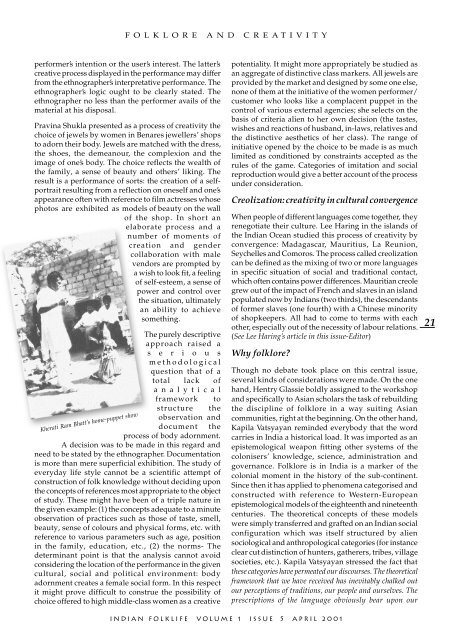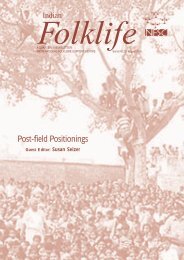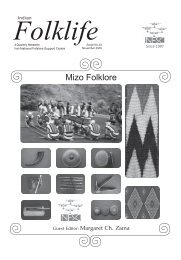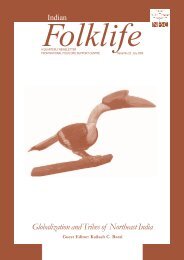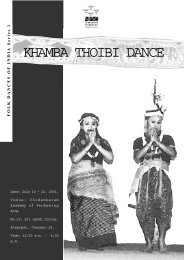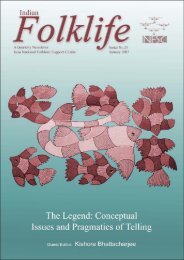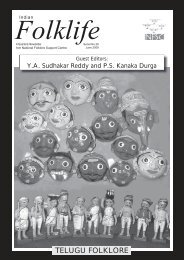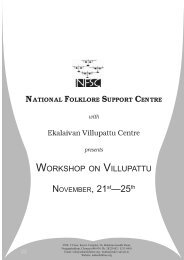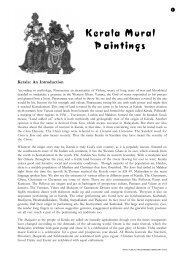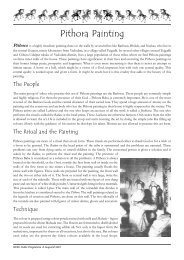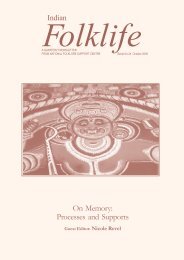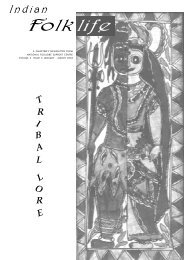FOLKLORE AND CREATIVITY20the strings). Gifted musicians tried to improve. Children weremade to listen and try for themselves in camps organised forthem. The manufacturing of instruments requires a complexknowledge of appropriate substances different for each part(teak wood, rose wood, brass, copper, horn, etc.),measurements (with fingers) and location (particularly difficultin the case of flat and vertical bridges). We tried and madeexperiments: our experience has taught us for instance thatfor the kamaicha the best skin is that of a six-month old goat.Not a single instrument is exactly of the same size as anotherone. All are unique. The manufacturing skills developedagain. The transmission of performing skills to youngboys since 1992 is now one of the most excitingexperiments. Komalda remarked: Our concern is formusical quality. I boycotted the harmonium. The Portugueseamong other many good and bad things such as the small poxbrought the harmonium. All folk instruments are traditionallyfor accompaniment and not meant to play solo. We promptthose who use harmonium to shift to kamaicha and abandonharmonium. We have remade three instruments: sarangi,kamaicha and ravanhatta. We shall now take up otherinstruments.As regards Rajasthani folk-tales, a few significantfeatures are worth reminding. First, the variety of genresshould be identified. For instance, to start with talescomposed or narrated against payment, come thegenealogies kept by the caste of Bhats. There are twotypes of Bhat, those who keep written records of familylineages and those who keep only an oral memory ofthem. The maintenance of genealogies is a necessarystatus symbol. Bhats visit once a year families who paythem to keep record of their descent, stay a couple ofdays, spend evening telling stories. The art requires ahighly ornamental rhetoric. Those who keep oralgenealogies are also acrobats, and work with poorpeople. Their stories start with Sun, Moon, and Waterand follow a format close to Puranas. (See Komal Kothari’sarticle in this issue-Editor)Creation: making and remaking of the worldThis title offered a framework for two presentationsthat tried to illustrate the theory of performance andthe process of documentation as two moments ofcreation with reference to a folk object with the help ofphotos and through a well-knit biographical narrative.Henry Glassie tried to draw the full life profile anddynamics of a Hindu potter (murti maker) in Bangladesh.The potter learned to make the murti by spending anumber of years visiting many artists in India andBangladesh and studying all the sixty eight possibleforms of the goddesses and their background narratives.Instead of following the written prescriptions of thesastras, he followed only his mystical inspiration, settingto work after long moments of prayer only during whichhe was granted a mental appearance of the devi. Hejust tried to shape his statue as a visual projection inthe clay of his internal vision. The clay is not fired, asthe seed of creation would go off the clay. The body of thegoddess cannot be fired. Perfect symmetric order of thebody and absolute brightness of the face display a figure,which transports the devotee out of the human, everyday life into the divine realm of gods. The murti is notthe god, only the receptacle of the divine. The deitydescends to communicate with the devotee and thedevotee’s world. It is a direct fusion and an exchange:the devi consumes the flowers that are offered to herwhile she responds to her devotee’s needs. Against avow the devotee is granted a son. When the meet isover, the statue becomes clay again and is thrown inthe river to merge with the silt of the delta. Once themurti’s function is over, the clay goes back to the earth.The overall documentation of a murti in Bangladeshwas meant to stand as a pattern of documentation oftwo creative processes. As a matter of fact, thepresentation was essentially displaying a third creativeprocess, that of the construction of a representation ofboth the processes by a third agent, the ethnographer,to a particular audience, that of the participants of theworkshop. The third process takes place in a contexttotally alien to the space and time of the first twoprocesses. In this respect, the exercise revealed at leasttwo pitfalls that the process of documentation mightfind hard to avoid when its logic is one of exemplificationof a general idea more than a scientific display structuredby analytical concepts. The determinant general idea,that of the mystical dimension of the process of murtimaking, was stressed to the point that thecorrespondence of the ethnographer’s discursive objectand the concrete actual murti became problematic.Reality tended to be turned into the pretext of anaesthetic constitution when the discourse on the beautyof the goddess was making one forget that the colours,the dresses, the jewels, the soft and white skin of thedevi’s plump face might have as much to do with theappearances of film actresses in the dream of youngfemale devotees than with the apparition of the devi tothe artist in prayer. Similar doubts were raised aboutthe measurements of the statue: to what extent werethey not borrowed from canonical texts, resulting froma negotiation between people’s tastes and normativedefinitions? To what extent can folk potters remain freefrom these norms, even if we assume that they neverread them and that sculptors strictly observe thesecanons? As a result the representation of theethnographer looking for an in-depth mysticalunderstanding of a tremendously ambitious potter couldhardly avoid the serious danger of actually standing asa marvellous piece of orientalist literature.This leads to the methodological question of the motives,which may, explicitly or implicitly, structure thediscourse of the documenting ethnographer. The truthof the latter might not be the same as that of theperformer who is documented. Everyone has his truth.Documentation is a process of representation, whichmay mirror the ethnographer’s truth more than the<strong>IN</strong>DIAN FOLKLIFE VOLUME 1 ISSUE 5 APRIL 2001
FOLKLORE AND CREATIVITYperformer’s intention or the user’s interest. The latter’screative process displayed in the performance may differfrom the ethnographer’s interpretative performance. Theethnographer’s logic ought to be clearly stated. Theethnographer no less than the performer avails of thematerial at his disposal.Pravina Shukla presented as a process of creativity thechoice of jewels by women in Benares jewellers’ shopsto adorn their body. Jewels are matched with the dress,the shoes, the demeanour, the complexion and theimage of one’s body. The choice reflects the wealth ofthe family, a sense of beauty and others’ liking. Theresult is a performance of sorts: the creation of a selfportraitresulting from a reflection on oneself and one’sappearance often with reference to film actresses whosephotos are exhibited as models of beauty on the wallof the shop. In short anelaborate process and anumber of moments ofcreation and gendercollaboration with malevendors are prompted bya wish to look fit, a feelingof self-esteem, a sense ofpower and control overthe situation, ultimatelyan ability to achievesomething.The purely descriptiveapproach raised as e r i o u smethodologicalquestion that of atotal lack ofanalyticalframework tostructure theobservation anddocument theprocess of body adornment.A decision was to be made in this regard andneed to be stated by the ethnographer. Documentationis more than mere superficial exhibition. The study ofeveryday life style cannot be a scientific attempt ofconstruction of folk knowledge without deciding uponthe concepts of references most appropriate to the objectof study. These might have been of a triple nature inthe given example: (1) the concepts adequate to a minuteobservation of practices such as those of taste, smell,beauty, sense of colours and physical forms, etc. withreference to various parameters such as age, positionin the family, education, etc., (2) the norms- Thedeterminant point is that the analysis cannot avoidconsidering the location of the performance in the givencultural, social and political environment: bodyadornment creates a female social form. In this respectit might prove difficult to construe the possibility ofchoice offered to high middle-class women as a creativeKherati Ram Bhatt’s home-puppet showpotentiality. It might more appropriately be studied asan aggregate of distinctive class markers. All jewels areprovided by the market and designed by some one else,none of them at the initiative of the women performer/customer who looks like a complacent puppet in thecontrol of various external agencies; she selects on thebasis of criteria alien to her own decision (the tastes,wishes and reactions of husband, in-laws, relatives andthe distinctive aesthetics of her class). The range ofinitiative opened by the choice to be made is as muchlimited as conditioned by constraints accepted as therules of the game. Categories of imitation and socialreproduction would give a better account of the processunder consideration.Creolization: creativity in cultural convergenceWhen people of different languages come together, theyrenegotiate their culture. Lee Haring in the islands ofthe Indian Ocean studied this process of creativity byconvergence: Madagascar, Mauritius, La Reunion,Seychelles and Comoros. The process called creolizationcan be defined as the mixing of two or more languagesin specific situation of social and traditional contact,which often contains power differences. Mauritian creolegrew out of the impact of French and slaves in an islandpopulated now by Indians (two thirds), the descendantsof former slaves (one fourth) with a Chinese minorityof shopkeepers. All had to come to terms with eachother, especially out of the necessity of labour relations.(See Lee Haring’s article in this issue-Editor)Why folklore?Though no debate took place on this central issue,several kinds of considerations were made. On the onehand, Hentry Glassie boldly assigned to the workshopand specifically to Asian scholars the task of rebuildingthe discipline of folklore in a way suiting Asiancommunities, right at the beginning. On the other hand,Kapila Vatsyayan reminded everybody that the wordcarries in India a historical load. It was imported as anepistemological weapon fitting other systems of thecolonisers’ knowledge, science, administration andgovernance. Folklore is in India is a marker of thecolonial moment in the history of the sub-continent.Since then it has applied to phenomena categorised andconstructed with reference to Western-Europeanepistemological models of the eighteenth and nineteenthcenturies. The theoretical concepts of these modelswere simply transferred and grafted on an Indian socialconfiguration which was itself structured by aliensociological and anthropological categories (for instanceclear cut distinction of hunters, gatherers, tribes, villagesocieties, etc.). Kapila Vatsyayan stressed the fact thatthese categories have permeated our discourses. The theoreticalframework that we have received has inevitably chalked outour perceptions of traditions, our people and ourselves. Theprescriptions of the language obviously bear upon our21<strong>IN</strong>DIAN FOLKLIFE VOLUME 1 ISSUE 5 APRIL 2001


